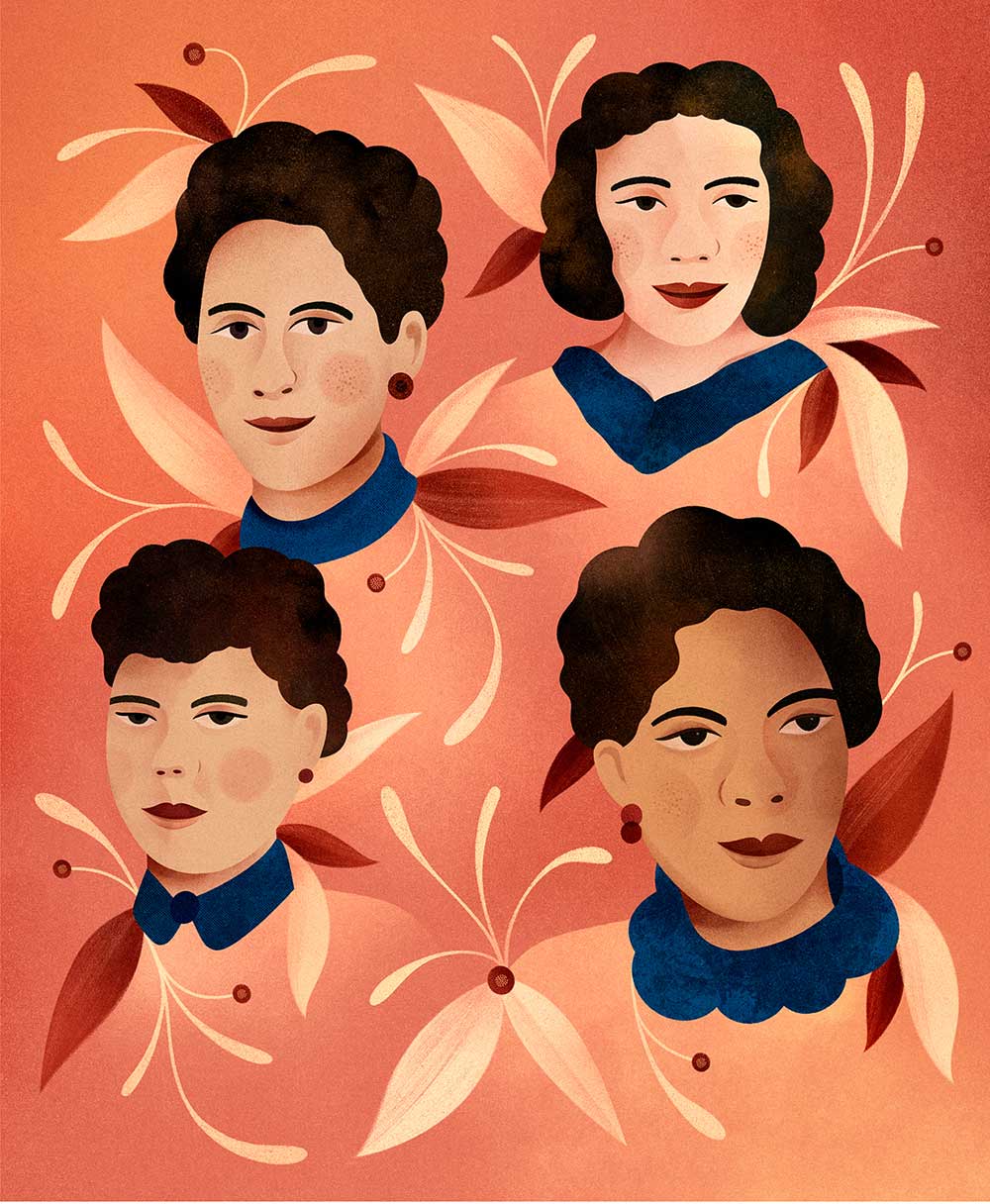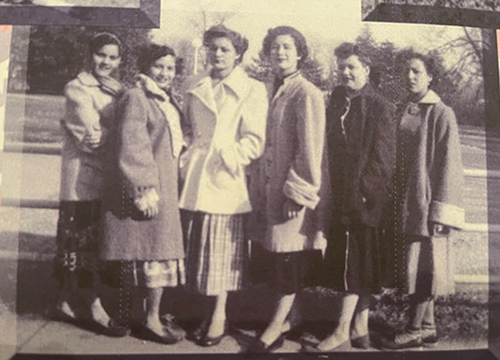Open homes, open hearts
During an unusually warm October in 1953, eight women exited an airplane — many of them from their first flight ever. They had journeyed from San Juan, Puerto Rico, to Dayton to be nurses at the Veterans Administration Medical Center. Four of them would go on to become Flyers, including Sylvia Acosta Fronista ’58 and Juana “Jenny” Diaz Honingford ’58, who over the years would tell stories of their arrival to their children.
“I remember Mom and Jenny saying that the mayor greeted them at the airport,” said Fronista’s daughter, Carmen Fronista Kaloush. Among the other women traveling with them were Virgenminna “Bove” McAfee Pardos ’60 and Lucila “Lucy” Vega Andrew ’66.

Their arrival was a momentous occasion for the city, as well as for the eight women. The Dayton VA was in need of nurses, and this group from Puerto Rico would help fill the vacant positions. The women also began new chapters in their lives, not realizing at the time just how far their perseverance and faith — and the value they placed on education and service — would take them.
In the early 1950s, many military nurses were recalled to active duty in the Korean War. This drained the VA system of registered nurses on the mainland, which caused a scarcity of nurses, especially when soldiers returned home in need of care. This group of eight who came to Dayton was believed to be among the first nurses recruited from U.S. territories, such as Puerto Rico, to work in VA hospitals to help with the shortage.
Together, the women persevered through challenges, like cultural differences between Ohio and Puerto Rico. “If you think about just the cultural adjustments they had to make, it’s incredible,” said Honingford’s son, Steve Honingford. He said his mom shared she was surprised when they arrived that no one seemed to know Puerto Rico was a commonwealth and part of the United States. She also said people asked her what they used as currency there.
At the VA, the nurses had a requirement to speak and complete all reports in English. Even though the group had learned English in school and had textbooks written in English, they arrived speaking little of the language.
The weather was another challenge. Ohio’s relatively cold weather was quite a change from Puerto Rico and required them to purchase coats and winter clothing soon after arriving in Dayton. And none of them had seen snow before that first winter in the Gem City.
But cultural and language differences — and the cold weather — did not deter these young women.
The group had met at the Presbyterian Hospital School of Nursing in San Juan. Through a nursing magazine, they learned the VA was looking for nurses. The women applied for the positions and chose the VA in Dayton because it was the location where all of them could be placed to work together — and they were offered the opportunity to pursue bachelor’s degrees in nursing from the University of Dayton.
The women valued education and believed it was a way to get out of a situation of poverty or to pursue a calling.
As a child, Jenny Honingford grew up in a small town and since it had no high school, she would ride with the garbage truck to the next town to attend school. She was awarded a full scholarship to the Presbyterian Hospital School of Nursing, and her community pitched in to pay for her uniform and books.
Andrew, who also grew up in poverty, was neighbors with a woman who was a nurse. When Andrew was a teenager, she visited this neighbor after school and listened to her stories. By the time she was in high school, Andrew knew she wanted to be a nurse.
In Puerto Rico, the women received training to become registered nurses, and their next goal was to receive their bachelor’s degrees. So, they enrolled in the nursing program at UD while continuing their full-time positions at the hospital.
Like other UD nursing students at the time, the women took advantage of the program’s flexibility to work different hours while pursuing their degrees. Honingford and Fronista worked during the day and took classes at night, while Pardos and Andrew worked the night shift and attended classes during the day.

By 1955, several from the original group of eight returned to Puerto Rico for various reasons, but Honingford, Fronsita, Pardos and Andrew remained. All four women went on to achieve their goal of earning bachelor’s degrees. Honingford — who was a member of the nurses’ honorary society, Nu Epsilon Delta — and Fronista completed their degrees in 1958, and Pardos in 1960.
Andrew took a break from school after marrying and becoming pregnant with her first child. She resumed her studies in 1959.
“I actually remember going to the campus with her,” said Andrew’s son, Tom Andrew ’78. “She would study in the library, and I would goof around in the gazebo that was outside the library or play under the table she was working at. So, I was frolicking on the UD campus long before I was a UD student.”
During the 1950s, the University revised its curriculum due to new accreditation requirements. In 1961, the chair of the Department of Nursing, Ann Franklin, submitted to the president a proposed four-year curriculum. Many Dayton-area nursing programs already demanded clinical time at area hospitals, and administrators worried there would be no room for more UD students. In 1964, UD canceled plans for the new degree program and admitted no new students to its current degree program. Nursing education at UD would cease to be.
Fortunately, Andrew was already in the program and able to complete her degree in 1966. In 2019, UD restarted its nursing program in partnership with Sinclair Community College. Once again, students looking to pursue the call to become a nurse can earn a Bachelor of Science in Nursing at the University of Dayton.
In addition to earning their degrees, Honingford and Fronista met their husbands — Tom Honingford ’58 and Harry Fronista ’58 — while attending UD. Through Fronista, Andrew met Harry’s friend Andy Andrew, and they married.
By this point, the sisterhood of the four women was rock solid. Their weddings not only extended their families but served as examples of how close these sisters by choice were. They were a part of each other’s weddings, and when Honingford’s mother could not make the trip from Puerto Rico to be at her wedding, the mothers of Fronista and Andrew attended for her.
Pardos, who met her first husband Louis McAfee when he was a patient at the VA, was a few years older than the other three women and had been their supervisor in the past. As a result, she was almost like a den mother to them.
“When guys would be interested in the other women, they would have to go through my mom,” said Pardos’ son, Lou McAfee. “Andy, Tom and Harry made the cut.”
Family was incredibly important to the women. Having left their families when they moved from Puerto Rico, the sisterhood maintained a close bond, even after they married and started their own families.
Among the four women, they had 13 children. And while they are not blood relatives, their children all think of each other as cousins. As they grew up, they were all present for each other throughout their lives. Kaloush chose Honingford to be her confirmation sponsor. “I just thought the world of Jenny, and the way she handled life with grace,” said Kaloush. “She had such great faith in God that I was like, ‘that’s the person that I want to be my sponsor.’”
While raising their families, Honingford, Fronista, Andrew and Pardos all continued working and showing leadership throughout their careers. Honingford worked with her husband at his medical practice in New Carlisle before taking a nursing position at Wright-Patterson Air Force Base Medical Center. Fronista and her
husband opened Huber Heights Medical Center, and Pardos and Andrew worked at the Dayton Mental Health Center training and mentoring nurses.
The women were also among the founding members of the Puerto Rican Cultural Society in Dayton. The society was founded in the 1970s to celebrate their culture and heritage and share it with others through events like A World A’Fair. Pardos performed in the society’s traveling singing group called Rondalla. For years, the women served as leaders in the organization.
In 2003, the Puerto Rican Cultural Society honored the group of eight women who came to Dayton in 1953 with a recognition dinner to celebrate the 50th anniversary of their arrival. Just as when they arrived, this occasion involved the mayor of Dayton, who declared the day of the event Puerto Rican Nurses Day.
In addition to their work with the society in Dayton, the women served members of the Puerto Rican and Dayton communities in various ministries and programs. Pardos helped found the Hispanic Catholic Ministry. Fronista was a member of the Incarnation Healing Ministry, and Honingford served in the St. Peter’s Bereavement Group. Andrew volunteered with St. Elizabeth Medical Center and the American Red Cross. The women also carried out their faith through service to others by sending care packages to their families in Puerto Rico and opening their homes in Dayton.
Steve Honingford recalls when he attended UD and met other students who were from Puerto Rico. “Most of them could not go back to Puerto Rico for Christmas, because they couldn’t afford it,” he said. “So, they all came to our house, and my mom made them traditional Puerto Rican food.”
Over the years, the women extended this welcoming spirit to others, regardless of their culture or status, and taught their own children to love and respect everyone.
“They opened their homes and their hearts to people of every culture, and because they came from humble beginnings, they treated everyone equally. That went along with their faith,” said Kaloush. “They were good to people of every socioeconomic strata, of different cultures, different races. It didn’t matter. They looked at the heart of the person.”
“They were good to people of every socioeconomic strata, of different cultures, different races. It didn’t matter. They looked at the heart of the person.”
Now, almost 70 years after they first landed in Dayton, the women are gone. Pardos died in 2007, Andrew in 2020 and Fronista and Honingford in 2022. Their children and grandchildren live across the country but continue to think of each other as family.
The four nurses who came to Dayton and stayed demonstrated that holding onto your culture is important, but to love everyone from all walks of life is essential. Each of them led by example and instilled in their children the value of education, faith, service and perseverance. As a result, their legacies live on.
Rhonda Havig joined the University of Dayton staff in 2016. She is honored to share this story about an amazing group of women who made a positive impact on the world around them.